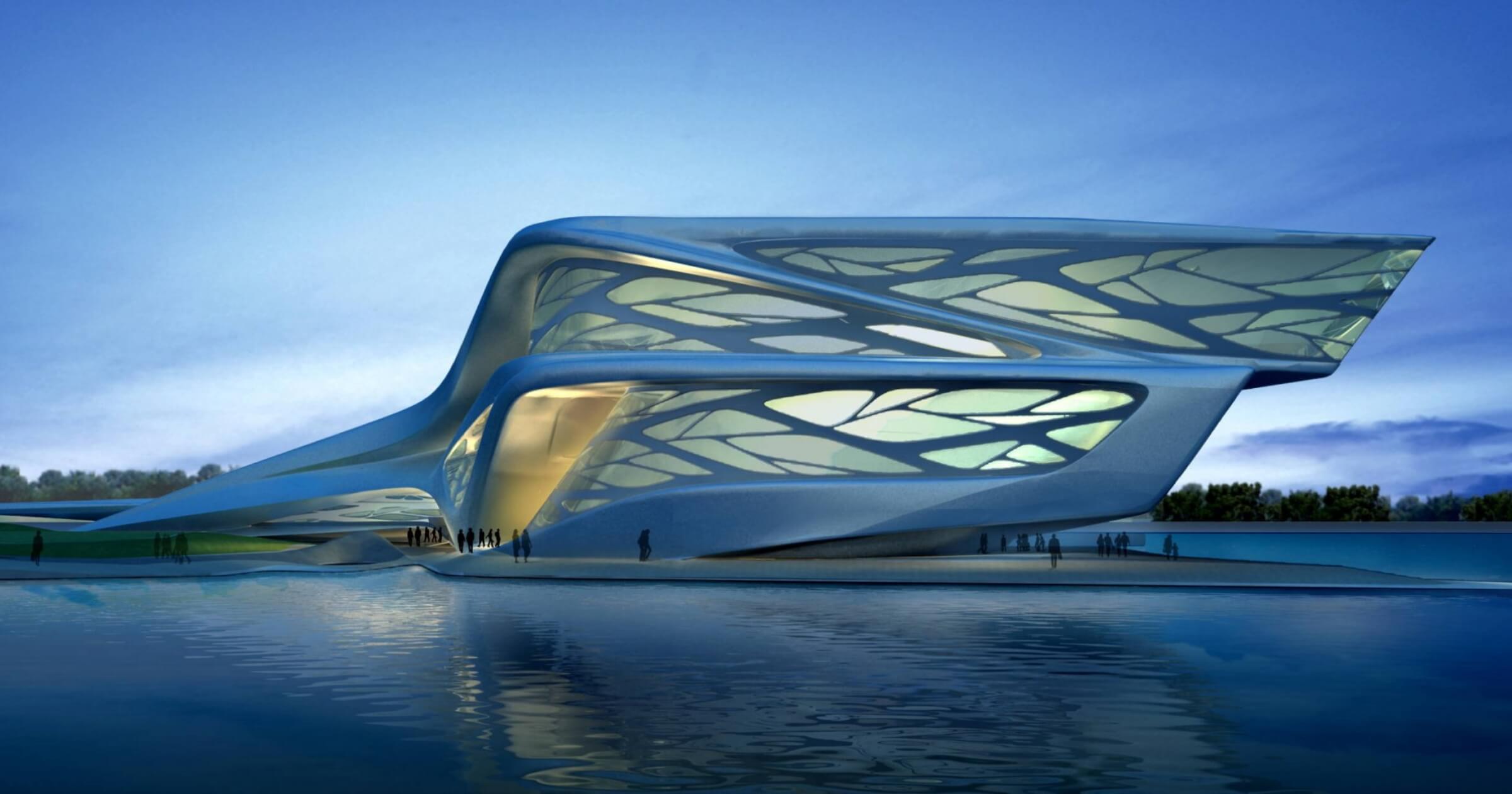Zaha Hadid Architects is known around the world for designing buildings that reshape skylines. With projects spanning continents and industries, their work blends bold ideas with eye-catching forms that feel more like sculpture than structure. From airports to cultural centers, this firm is creating spaces that are as functional as they are unforgettable.
Quick look
- Zaha Hadid Architects continues to redefine architecture across typologies and continents with sculptural, sustainable, and futuristic design.
- Key projects include Beijing Daxing Airport, BEEAH Headquarters, and One Thousand Museum, each pushing engineering and aesthetic boundaries.
- Designs emphasize walkability, climate-responsive forms, and community-integrated masterplans from China to the UAE and the U.S.
- From net-zero campuses to all-wood stadiums, ZHA blends visual dynamism with ecological innovation across public and private developments.
8 Past, present, and future projects on the go from Zaha Hadid Architects
Unicorn Island Masterplan
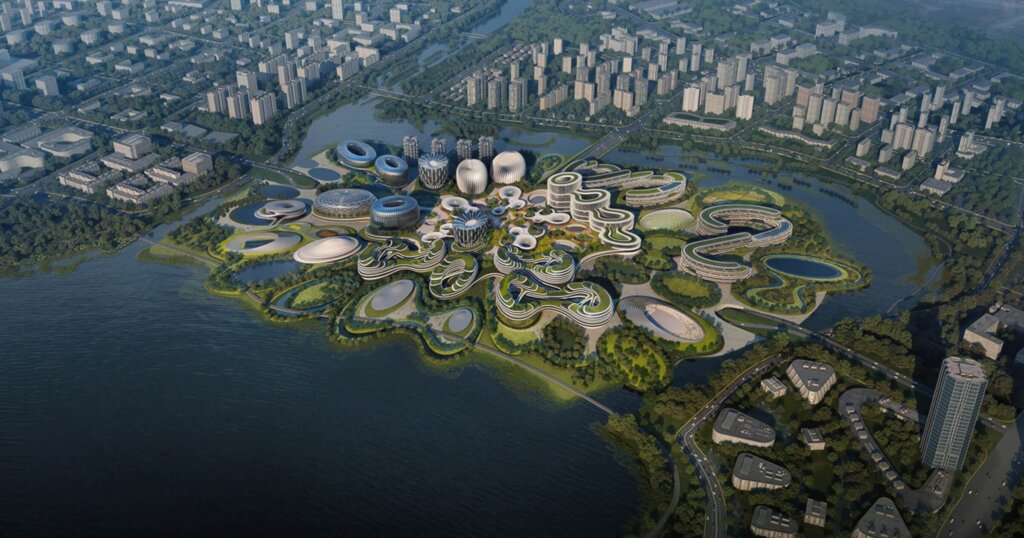
Photo courtesy of https://www.zaha-hadid.com/
- Location: Chengdu, China
- Year built: Ongoing (phased completion began in 2020)
- Typology: Urban masterplan/business district
Unicorn Island is a 67‑hectare mixed‑use development designed to nurture China’s high-tech economy by creating a vibrant ecosystem for startups, researchers, residents, and visitors. Its radial layout organizes clusters of buildings around a central plaza and metro station, making every part of the island reachable within a few minutes on foot or by bike.
The firm envisioned this as more than just architecture. Inspired by the ancient Dujiangyan irrigation system, the plan weaves wetlands, urban farms, and public parks into the design to support ecological balance and wellbeing. Together, these features serve over 70,000 people and reflect an approach to design that blends community, sustainability, and connectivity.
The first building, a Start‑Up Exhibition and Conference Centre, neared completion in early 2020 and showcases Zaha Hadid’s signature flowing forms. This structure provides event space and offices mounted within curved clusters beside water features and landscaped terraces.
Beijing Daxing International Airport
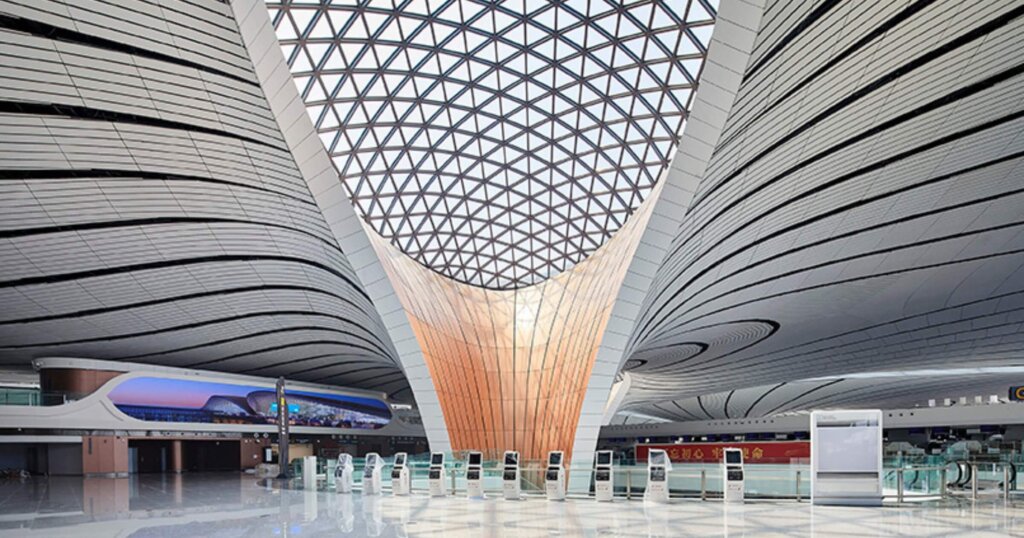
Photo courtesy of https://www.zaha-hadid.com/
- Location: Beijing, China
- Year built: 2019
- Typology: Transportation/airport terminal
Dubbed the “starfish” terminal, this is one of the world’s largest single-building airport terminals, designed to serve up to 100 million passengers annually through a compact radial layout that feels like a giant, flowing sculpture.
The terminal spreads across approximately 700,000 m² inside a single structure, with six sweeping arms radiating from a central hub, making the longest walk from check‑in to gate no more than 600 meters, or about eight minutes. This promotes smooth circulation and easy transfers across domestic, international, and transit zones.
The design embraces natural light with sculpted roof vaults, skylights, and soaring C‑shaped columns that flood the concourse with daylight while guiding passengers intuitively through the space. The collaboration between Zaha Hadid Architects and ADP Ingénierie produced a terminal that merges futuristic fluidity with traditional Chinese courtyard logic, creating central communal space, retail pods, and amenities all within one flowing architectural language.
From 45 million passengers initially to an expected 72 million by 2025 and eventually 100 million, Daxing is an infrastructure cornerstone built for future growth.
BEEAH Headquarters
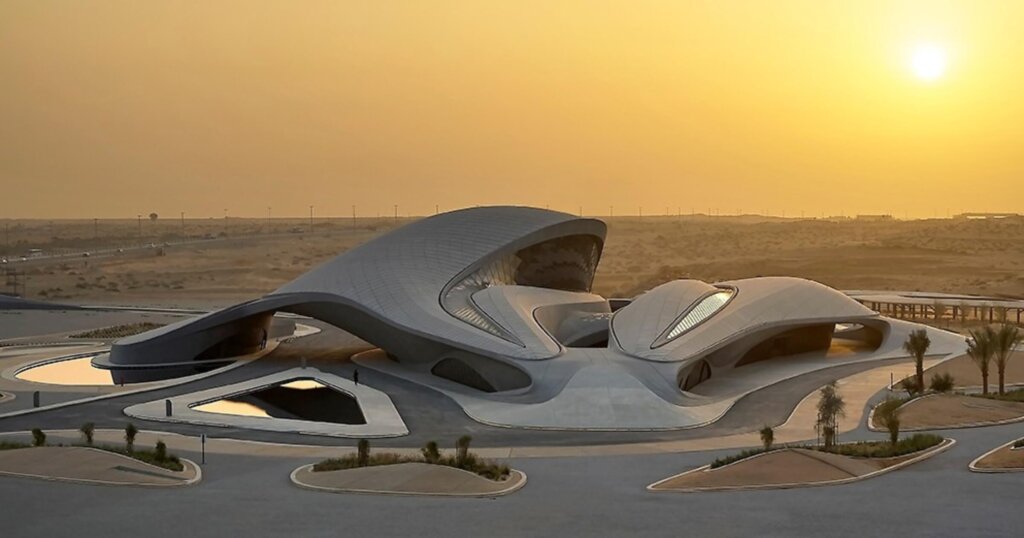
Photo courtesy of https://www.zaha-hadid.com/
- Location: Sharjah, United Arab Emirates
- Year built: 2022
- Typology: Corporate headquarters
The BEEAH Headquarters is a striking example of how bold architecture and sustainable design can come together. Shaped like a series of undulating desert dunes, the building blends organically into Sharjah’s Al Sajaa landscape, creating a futuristic yet grounded space for BEEAH Group’s sustainability mission.
As a net‑zero energy facility, the building is powered entirely by on‑site photovoltaics and stores excess electricity in Tesla battery packs to run around the clock. The architecture team used glass‑fibre reinforced concrete panels and cooling strategies such as slab and glass regulation to minimize solar heat gain, helping the headquarters achieve LEED Platinum certification.
Inside, the layout consists of two primary “dunes” housing public and administrative areas, connected through a central courtyard that doubles as a shaded natural ventilation core. Visitors enter under a 15‑metre concrete dome that floods the space with passive light while enhancing airflow. Smart technologies, such as AI-driven occupancy-based lighting and thermal controls, a virtual concierge, and hybrid-ready meeting rooms, enable the building to learn and adapt throughout the day.
The headquarters is also a working showcase for BEEAH Group’s sustainability values, mainly built with locally sourced and recycled materials, featuring on‑site water treatment to limit use, and constructed using zero‑waste standards. Recognized globally, it has earned awards including Architectural Design of the Year in the BLT 2022 Awards and cemented BEEAH’s position as a leader in sustainable corporate design.
One Thousand Museum
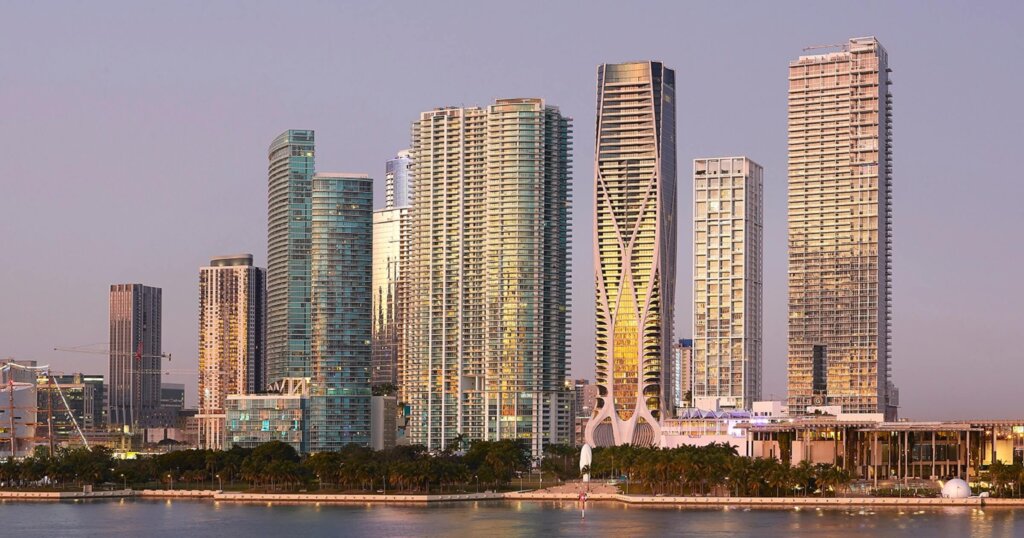
Photo courtesy of https://www.zaha-hadid.com/
- Location: Miami, Florida, USA
- Year built: 2019
- Typology: Residential high‑rise
Zaha Hadid Architects’ first residential skyscraper in the Western Hemisphere, the One Thousand Museum tower, soars 62 stories above downtown Miami at 707 ft. Completed in 2019, this ultra‑luxury building features only 84 residences, including full-floor and half‑floor units and a dramatic duplex penthouse with rooftop helipad.
At the heart of the design is a sinuous concrete exoskeleton composed of around 5,000 glass-fibre reinforced concrete panels. This structural frame wraps the building in flowing curves that provide strength against hurricane winds, eliminate almost all interior columns, and create open, flexible living spaces.
Inside, the tower offers a full suite of luxury amenities: an aquatic center and indoor pool on the 60th floor, spa and wellness facilities, exclusive sky lounges, event spaces, and chilling areas, all framed by dramatic, curved architectural forms and minimal right angles in keeping with Hadid’s design philosophy.
Located opposite Museum Park and overlooking Biscayne Bay, One Thousand Museum combines high engineering ambition with visual elegance to create a sculptural landmark experience for residents and Miami’s skyline alike.
Aljada Central Hub (Madar)
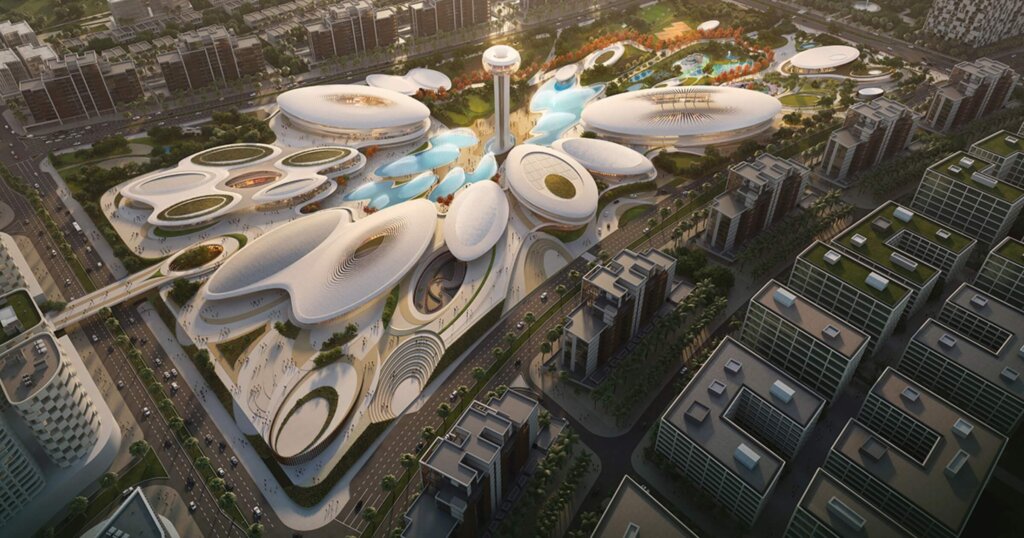
Photo courtesy of https://www.zaha-hadid.com/
- Location: Sharjah, United Arab Emirates
- Year built: 2020 (phase 1 complete in March 2020)
- Typology: Mixed‑use public space
Aljada Central Hub is a signature public destination that anchors the larger Aljada masterplan. At its core is a branching canopy of oval buildings inspired by a water droplet hitting the desert floor, shaping a futuristic yet natural urban form that channels prevailing winds into shaded courtyards and plazas.
The Hub spans around 1.9 million sq ft, roughly 25 football fields, with 732,000 sq ft dedicated to parks, gardens, and civic space. Designed to remain comfortable even in summer heat, it uses water recycling, solar-powered lighting, and passive cooling strategies combined into a car-free, walkable environment.
Phase 1, completed in early 2020, unveiled key visitor attractions: an outdoor cinema, food truck village, skate park, children’s play area, and Arada’s experiential sales centre, all built within 328,000 sq ft of activated space. Development continues with future phases set to introduce waterplay zones, an extreme sports center, family ‘edutainment’ facilities, a cinema complex, adventure golf, and a lush 340,000 sq ft community park featuring native trees and recreational amenities.
This project truly reflects Hadid’s vision for architecture working in harmony with climate and culture, transforming Sharjah’s urban fabric through bold, sustainable design.
King Abdullah Petroleum Studies and Research Center (KAPSARC)
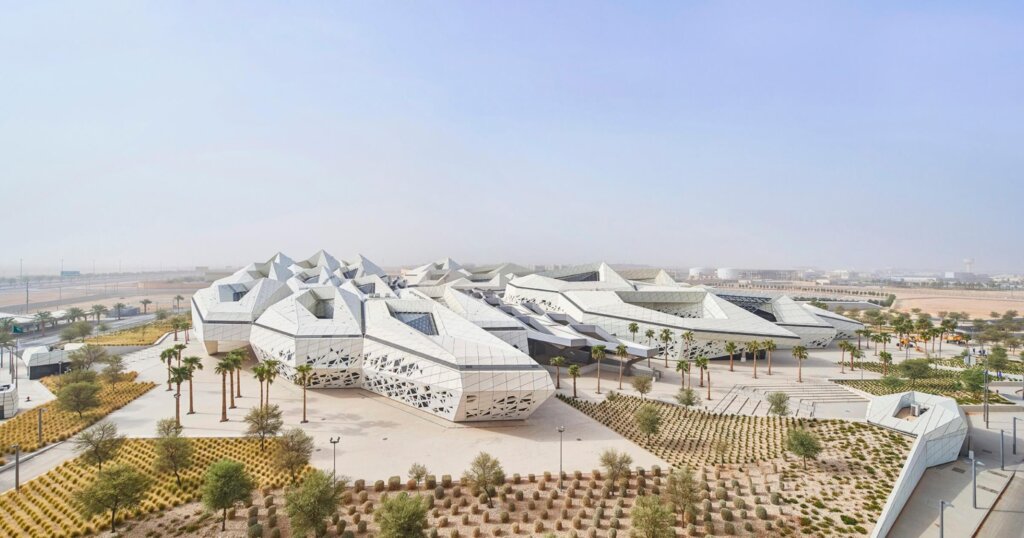
Photo courtesy of https://www.zaha-hadid.com/
- Location: Riyadh, Saudi Arabia
- Year built: 2017
- Typology: Institutional / research facility
KAPSARC is an energy and environmental research campus designed for Saudi Arabia’s global think tank, rising from the desert solidscape like crystalline honeycomb forms that house a network of interlocking spaces. Covering approximately 70,000 m², the complex includes five interconnected buildings: the Energy Knowledge Centre, the Energy Computer Centre, a conference centre with exhibition hall and 300‑seat auditorium, a research library holding 100,000 volumes, and the Musalla, a contemplative space for prayer.
ZHA used a cellular modular layout of hexagonal prismatic pods to adapt to programmatic needs while minimizing material use. The design orients structures to face away from the southern sun, opening north and west to welcome prevailing desert breezes. Self-shading courtyards, angled façades, and daylight-filled interiors are key sustainability strategies embedded in the structural logic.
On the environmental front, KAPSARC became ZHA’s first project to earn LEED Platinum certification. Its design includes on-site photovoltaic generation, potable water recycling, and the use of locally sourced and recycled materials; 40% of materials were recycled content, and 40% were sourced within a 500-mile radius.
The overall effect is a campus built to perform under extreme climatic conditions and to grow as a living organism; an architectural metaphor for research, connectivity, and energy optimization in action.
Esfera City Center Phase II
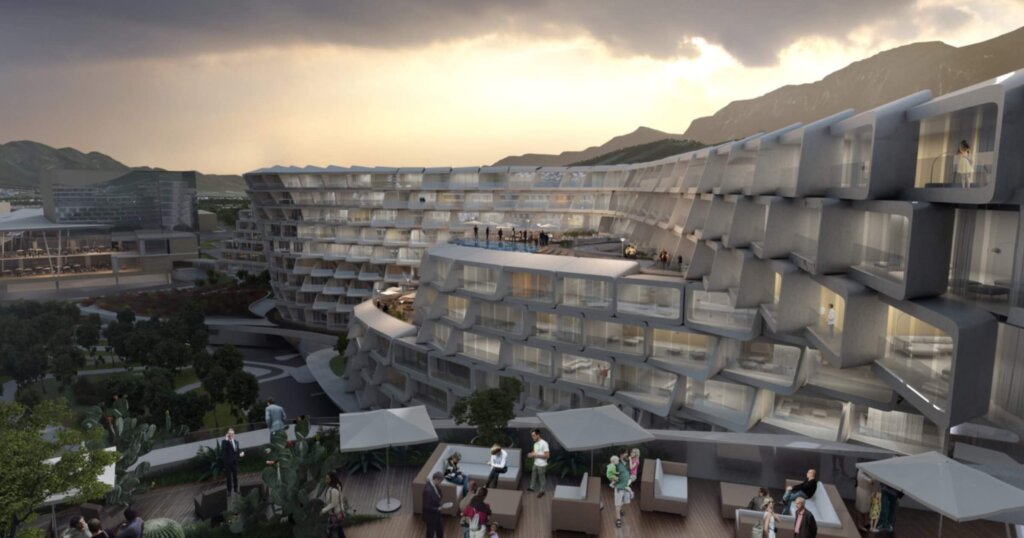
Photo courtesy of https://www.zaha-hadid.com/
- Location: Monterrey, Mexico
- Year built: TBD (in development)
- Typology: Residential
Esfera City Center marks Zaha Hadid Architects’ first built venture in Mexico and explores fluid, organic residential design within Monterrey’s Huajuco Canyon.
Rather than erecting the originally planned twelve high-rises, the firm proposed a low-rise yet high-density configuration consisting of 981 apartments across interconnected sinuous volumes that curve around a central public park. These sheltered pathways, balconies, and terraces echo local morphology and traditional lattice motifs while mitigating solar exposure and maximizing natural ventilation.
The heart of the scheme is a 30,000 m² panoramic park framed by the residential blocks, featuring amenities such as a clubhouse, gym, amphitheater, café, and quiet zones for relaxation and community gathering. Orienting the building mass toward prevailing winds and away from the adjacent highway corridor enhances onsite comfort and helps foster a sense of shared community within the development.
Though still under development, Phase II promises to build on this ethos, merging sculptural skyline‑scale living with climate‑aware design and a focus on connectivity, community, and the natural terrain.
Forest Green Rovers Eco Park Stadium
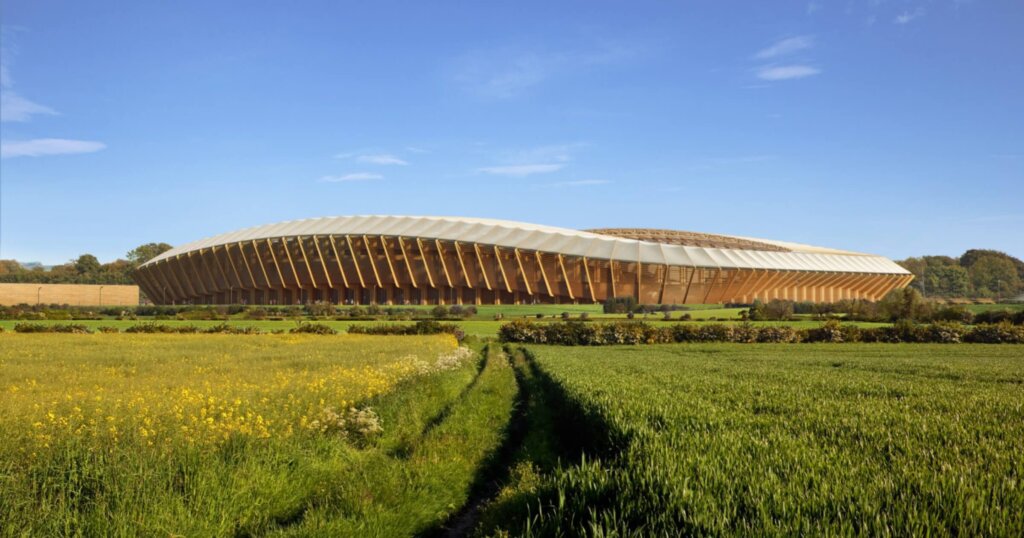
Photo courtesy of https://www.zaha-hadid.com/
- Location: Gloucestershire, UK (Eastington, near Stroud)
- Year built: TBD (approved in 2019)
- Typology: Sports facility
Zaha Hadid Architects has designed what would be the world’s first all-wood football stadium for Forest Green Rovers, the club celebrated as the “greenest team in the world.” Planning permission was granted in December 2019 following a competition held in 2016, with revised designs unveiled in 2022.
The stadium is planned as a sculptural bowl made primarily from sustainably sourced timber, including the structural frame, roof cantilevers, louvered cladding, seating terraces, and floor slab, marking a radical departure from conventional concrete and steel stadiums. A translucent membrane roof covering aims to support turf health, soften shadow lines on the pitch, and minimize visual impact on the surrounding landscape.
With an initial capacity of 5,000, expandable to 10,000 if the club progresses, the design positions every seat as close as five meters from the pitch to maximize spectator engagement. The continuous, compact bowl form also enhances acoustics and matchday energy.
Eco Park is part of a broader £100 million sustainable development led by green energy company Ecotricity. The masterplan includes renewable energy infrastructure, wetlands, additional pitches, commercial space, and public realm enhancements. The development is expected to plant roughly 500 trees, 1.8 km of hedgerows, and support biodiversity throughout, even on non‑matchdays.
The whole vision is carbon-neutral, or even carbon-negative, powered by on-site solar and wind energy. With this stadium, ZHA aims to demonstrate sustainable stadium design that blends powerful visual identity with ecological innovation.
Bottom line
From sculptural airports and sweeping sports arenas to carbon-neutral campuses and fluid residential blocks, Zaha Hadid Architects continues to challenge what architecture can be. Their projects prioritize experience, sustainability, and a deep connection to place. Whether it’s designing for future tech hubs or creating all-wood stadiums that push the boundaries of green building, ZHA’s work reflects a bold, future-forward mindset rooted in elegance and innovation.
Want more deep dives into iconic builds, industry breakthroughs, and design leaders redefining the built world? Subscribe to our newsletter and stay inspired.
